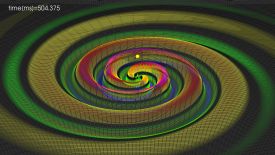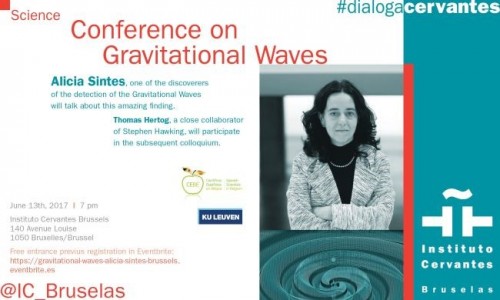Blog del Instituto Cervantes de Bruselas
Biblioteca Gerardo Diego
Ondas gravitacionales: ¡así suena el universo… por fin! Gravitational Waves, the sounds of the Universe… finally!
100 años después de los enunciados del genio alemán, Albert Einstein, nadie había logrado observar las Ondas Gravitacionales: ondulaciones del espacio-tiempo producidas por acontecimientos muy violentos, como la explosión de una estrella nueva gigante, supernova, o la fusión de dos agujeros negros. Einstein murió pensando que estas ondas jamás serían detectables.
Los padres del descubrimiento: David Reitze y Alicia Sintes hicieron una declaración de trascendencia histórica ante la prensa internacional: «Hemos detectado ondas gravitacionales. ¡Por fin lo conseguimos!». Igualmente, sentenciaron que, Hasta ahora hemos estado sordos ante el Universo. Hoy, somos capaces de oír las ondas gravitacionales por primera vez. Esto marca el inicio de la Era de la Astronomía Gravitacional. Incluso el gran experto en agujeros negros, Stephen Hawking quiso sumarse a estas entusiastas reacciones. Se trata, por tanto, de uno de los mayores hallazgos de las últimas décadas. Ningún otro hito tecnológico en décadas -salvo quizá el del Bosón de Higgs en 2012- había suscitado tanta expectación como éste, pues tal descubrimiento supone un cambio de paradigma, una nueva forma de concebir el universo de manera diferente a la que habíamos heredado de Galileo.
La doctora en Física Alicia Sintes (Mahón, 1969) es la investigadora que lidera la participación del Grupo de Relatividad y Gravitación (GRG) de la Universidad de las Islas Baleares en la colaboración científica internacional LIGO, en el marco de la cual se hizo la primera detección de las ondas gravitacionales el 14 de setiembre de 2015. El GRG es el único grupo de investigación en España que participó en este hito. Profesora titular en el área de Física Teórica, su investigación se desarrolla en el campo de la astronomía de las ondas gravitacionales.
Es experta en la puesta a punto de detectores interferométricos y en el estudio y la investigación de estrellas de neutrones y sistemas binarios de los agujeros negros. Ha realizado estancias en Estados Unidos, Canadá, Reino Unido, Alemania, Austria, Italia y Portugal, y colabora científicamente con LIGO y GEO; ha participado como colaboradora en la misión espacial LISA y en el diseño de futuros detectores tipo Einstein Telescope. Ha sido asesora científica de la Agencia Espacial Europea y miembro del grupo G8 de la Red de Infraestructuras de Astronomía en el período 2007-2010.
Alicia Sintes estará acompañada de Thomas Hertog (Leuven, 1975) profesor de Física Teórica de la Universidad de Lovaina, reconocido cosmólogo y estrecho colaborador de Stephen Hawking.
¡Te esperamos el 13 de junio en nuestro centro, Instituto Cervantes. Luizalaan 140 Avenue Louise. 1050 Bruselas!
La actividad será en inglés. Entradas gratuitas en: Eventbrite
 Einstein’s old dream was confirmed in 2016 by more than a thousand scientists from fifteen different countries participating in the Advanced LIGO Program, and among them, the Spanish scientist Alicia Sintes (Mahón, 1969), the group leader on Gravitational Wave Astronomy at the University of the Balearic Islands, she joined the GRG group as associate professor in 2002, and initiated the group’s participation in the GEO and LIGO Scientific Collaborations. Since 2002 she has been the PI for the group’s participation within the LIGO Scientific Collaboration and a member of the LIGO-LSC council. Furthermore Sintes was member of the G8 group of the “Red de infraestructuras de Astronomía” (2007-2009), member of the “Red de Interlocutores Universitarios” for the EU 7FP, Space & Security group, Servicio Europa I+D -CRUE in 2006. Sintes has extensive experience in developing code for the LIGO Algorithms library software infrastructure, developing and running actual searches, and has pioneered parameter estimation studies for the space mission LISA. Alicia Sintes and her team are leading quick look searches for unknown isolated pulsars and spinning neutron stars in the data from Advanced LIGO detectors.The detection of these gravitational waves will allow us to expand our knowledge of some of the most rare and violent phenomena of the cosmos, such as black hole collisions, supernova explosions, gamma rays or the Big Bang itself. We will be able to know what happened when the universe was created. Do not miss this opportunity to hear the main scholar on the Relativity and Gravitational Group from the Universitat de les Illes Balears, and the only Spanish member of the Advanced LIGO Program.
Einstein’s old dream was confirmed in 2016 by more than a thousand scientists from fifteen different countries participating in the Advanced LIGO Program, and among them, the Spanish scientist Alicia Sintes (Mahón, 1969), the group leader on Gravitational Wave Astronomy at the University of the Balearic Islands, she joined the GRG group as associate professor in 2002, and initiated the group’s participation in the GEO and LIGO Scientific Collaborations. Since 2002 she has been the PI for the group’s participation within the LIGO Scientific Collaboration and a member of the LIGO-LSC council. Furthermore Sintes was member of the G8 group of the “Red de infraestructuras de Astronomía” (2007-2009), member of the “Red de Interlocutores Universitarios” for the EU 7FP, Space & Security group, Servicio Europa I+D -CRUE in 2006. Sintes has extensive experience in developing code for the LIGO Algorithms library software infrastructure, developing and running actual searches, and has pioneered parameter estimation studies for the space mission LISA. Alicia Sintes and her team are leading quick look searches for unknown isolated pulsars and spinning neutron stars in the data from Advanced LIGO detectors.The detection of these gravitational waves will allow us to expand our knowledge of some of the most rare and violent phenomena of the cosmos, such as black hole collisions, supernova explosions, gamma rays or the Big Bang itself. We will be able to know what happened when the universe was created. Do not miss this opportunity to hear the main scholar on the Relativity and Gravitational Group from the Universitat de les Illes Balears, and the only Spanish member of the Advanced LIGO Program.
Alicia Sintes will be accompanied by Thomas Hertog (Leuven, 1975). He received his undergraduate degree from the University of Leuven, Belgium, and his doctorate from the University of Cambridge. He joined the University of California as a research fellow in 2002 and became a fellow at CERN, Geneva, in 2005. He returned to Belgium in 2011 where he is currently Professor of Theoretical Physics at the University of Leuven.
Thomas Hertog is an internationally renowned cosmologist and a close collaborator of Stephen Hawking. He leads a research team that investigates how string theory applies to the real universe, hereby elucidating the physical nature of the big bang. He has lectured at both a general and a technical level in more than 25 countries, and his research has featured in distinguished media channels on numerous occasions. He lives with his wife and their four children in Bousval, Belgium.
The talk will be in English.
With the collaboration of CEBE/SSBE (Científicos Españoles en Bélgica/Spanish Scientists in Belgium).
Registrations: Eventbrite

